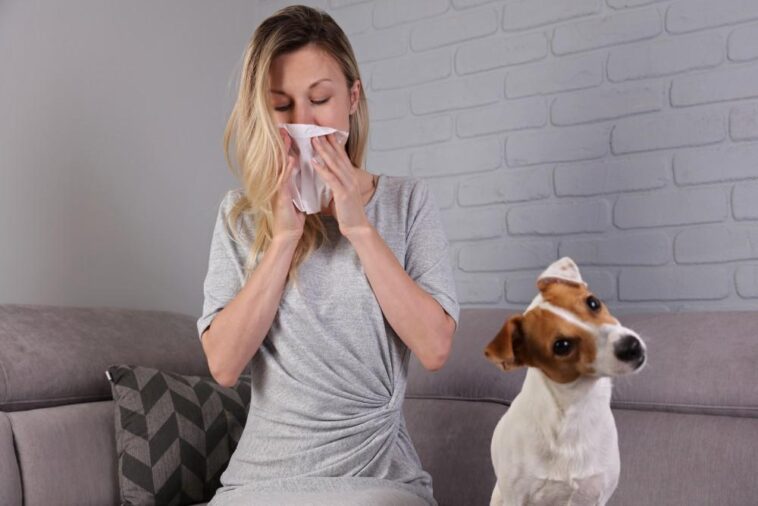When we think of pet allergies, we’re usually pretty self-involved about it. We worry our furry friends will give us watery eyes and runny noses. We avoid the homes of friends with pets so we don’t get sneezy or develop a rash. We put flea collars on pets so we don’t get pesky, itchy little bites. It’s all about us, us, us — but what about when our beloved animals experience the same terrible symptoms, or worse?
If your pet has allergies, they could be having a number of different symptoms. They could have stomach issues like vomiting and diarrhea, possibly because of a food allergy. Or they could develop itchy rashes or hives due to environmental allergens. Seasonal allergies could cause mild coughing, wheezing, or other symptoms. Here are some ways to defend your pet against the causes and symptoms of various allergies.
1. Upgrade Their Diet

Some animals are allergic to common pet food ingredients. Some of the most common food allergies in cats and dogs include beef, chicken, fish, dairy, wheat, soy, and eggs. Symptoms of food allergies in pets include gastrointestinal troubles, hives or itching, and swelling in the face. If you suspect your pet is allergic to their food, you’ll want to make an appointment with a veterinarian. They can test for allergies, prescribe medications or creams, and recommend dietary changes.
Even if your pet isn’t allergic to a specific ingredient, it might be time to consider changing up what they eat. According to Nom Nom, your pet’s gut microbiome can have a huge impact on their immune system. Feeding your pet a healthy, balanced diet of fresh dog food can help keep them feeling better overall, regardless of what allergies they have. Choosing the right pet food could mean they’ll be less likely to experience severe symptoms of food, environmental, or other allergies.
2. Monitor Their Environment
There are many allergens in and outside the home that could be triggering your pets’ symptoms. Grass, trees, pollen, insects, and even fungi can cause allergy symptoms on walks and trips. At home, dust mites, mold, mildew, chemical irritants, and even dander from other pets could be the culprit. Certain houseplants and some materials used in bedding, like wool and down, can also cause reactions. Smoking and vaping can cause symptoms like respiratory or skin issues as well.
To protect your pet from environmental allergens, keep your home clean and free from dust, mold, and mildew. But when you clean, use pet-safe products with natural ingredients. If symptoms persist, try using an air purifier to keep dust and contaminants out of your pet’s lungs. When you take your pet outside, consider location and timing. When possible, walk them at low-pollen times of day and avoid vegetation that’s caused them problems in the past.
3. Keep them Clean and Pest-Free

To further ward off environmental allergens, keep your pet as clean as possible — in accordance with any vet recommendations. Gently wash or wipe down your pet’s paws when they come inside from the yard or from a walk. You can use a hypoallergenic grooming wipe or a solution of water and apple cider vinegar. Bathe your dog once or twice a week with a hypoallergenic, pet-friendly shampoo. Brush or comb them to remove any stubborn particles they might by carrying around in their fur.
While no pet likes fleas, some cats and dogs have flea allergies that can cause intense itching and other symptoms. To prevent this reaction, known as flea allergy dermatitis, use a flea collar, a spray, or wipes. To reduce the risk of flea exposure, keep your pet away from strays or wild animals. Check your pet regularly for fleas or signs of fleas, like itching, dry skin, hair loss, or lesions. If symptoms are serious, schedule a vet visit for flea medication and consider minimizing your pet’s time outdoors.
4. Get Them Tested and Treated
No matter what’s causing your pet’s allergies or how mild the symptoms, it’s important to schedule a vet visit. If necessary, your vet will be able to test and accurately diagnose your pet’s allergies. They can also make specific recommendations for foods, cleaning products, or other changes that might help. In some cases, a prescription medication may be necessary to help control your pet’s symptoms. They may also need other treatments like allergy shots.
Your vet may also be able to make recommendations for over-the-counter medications you can safely use at home. Antihistamines like Benadryl and Zyrtec can be safe for some pets with respiratory symptoms, if the dosage is carefully controlled. If your pet’s allergies are causing gastrointestinal issues, you may be able to give them antacids or antidiarrheals like Imodium. Don’t give any human medications to your pet without checking with your vet first. And make sure you keep containers sealed and out of pets’ reach to avoid accidental overdose.

Making Sure Your Pet is Healthy and Safe
All of these methods can help if your pet is experiencing mild to moderate allergy symptoms. But none are a replacement for immediate medical attention when your pet has a severe allergic reaction like anaphylaxis. If your pet experiences severe symptoms like seizures, difficulty breathing, extreme coughing, or choking, get them to an emergency vet immediately. Take them straight to the emergency vet if they have repeated vomiting or bloody diarrhea. Also call your vet or seek rapid care if their face is swollen, or they have hives.




